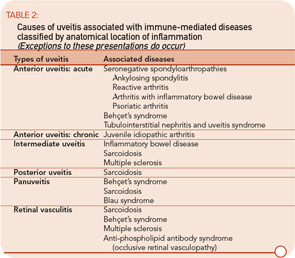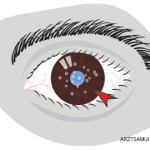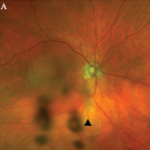Approximately half of patients develop uveitis prior to onset or diagnosis of IBD. The activity of uveitis does not often parallel the gastrointestinal disease activity, but scleral inflammation may. Uveitis is strongly related to sacroiliitis and arthritis. Of patients with IBD, 20% may have sacroiliitis; of these patients, 60% are HLA-B27–positive. Patients with IBD who have acute iritis tend to be HLA-B27–positive and have sacroiliitis. In contrast, patients with IBD who develop sclerouveitis tend to be HLA-B27–negative and have no sacroiliitis.7,8
Psoriatic arthritis: AAU is associated with psoriatic arthritis. An association between uveitis and psoriasis without arthritis has been reported. Eye involvement associated with psoriatic arthritis includes conjunctivitis, anterior uveitis, and scleritis. Like patients with IBD, patients with psoriatic arthritis often have nongranulomatous, recurrent anterior uveitis, but insidious chronic bilateral inflammation has frequently been reported as well.9
Acute Anterior Uveitis: TINU Syndrome
Although most rheumatologists are unfamiliar with the tubulointerstitial nephritis and uveitis (TINU) syndrome, the disease is more common than generally appreciated. Importantly, the clinical manifestations, which include fever, arthralgias, and fatigue in association with a markedly elevated sedimentation rate, can be confused with many autoimmune processes. The most common ocular manifestation of the TINU syndrome is bilateral, sudden-onset, anterior uveitis. The disease can present in one eye initially, with the second eye becoming clinically involved within four months.
TINU has been found in 10% of patients with bilateral, sudden-onset anterior uveitis; the percentage jumps to 32% in patients under 20. The onset of renal disease may precede or simultaneously present at the onset of uveitis. Renal disease following ocular involvement is less common. The course of uveitis is persistent in most patients, with a median duration of seven months. While some patients can have chronic uveitis for years, patients generally achieve excellent visual prognosis and good renal function with limited use of topical and short-course oral corticosteroids.10
Chronic Anterior Uveitis: JIA
Inflammation of the anterior segment that persists longer than three months is termed “chronic anterior uveitis.” Some experts also use the term “chronic” to mean the opposite of acute (“chronic” is sometimes equated with insidious onset). Because insidious onset of inflammation is typical of the eye disease among children with juvenile idiopathic arthritis (JIA), some patients are asymptomatic and incidentally diagnosed in a school screening examination.
JIA is the most common systemic disorder associated with iridocyclitis in children. Among the subsets of JIA, the vast majority of patients who have uveitis are in the pauciarticular group. The average age of onset of uveitis is six. Uveitis generally develops within five to seven years of the onset of joint disease but may occur as long as 28 years after the development of arthritis. Ocular inflammation is not related to joint disease activity. Girls with pauciarticular disease and a positive antinuclear-antibody test are at high risk to develop chronic uveitis. Most patients have a negative rheumatoid factor.11




